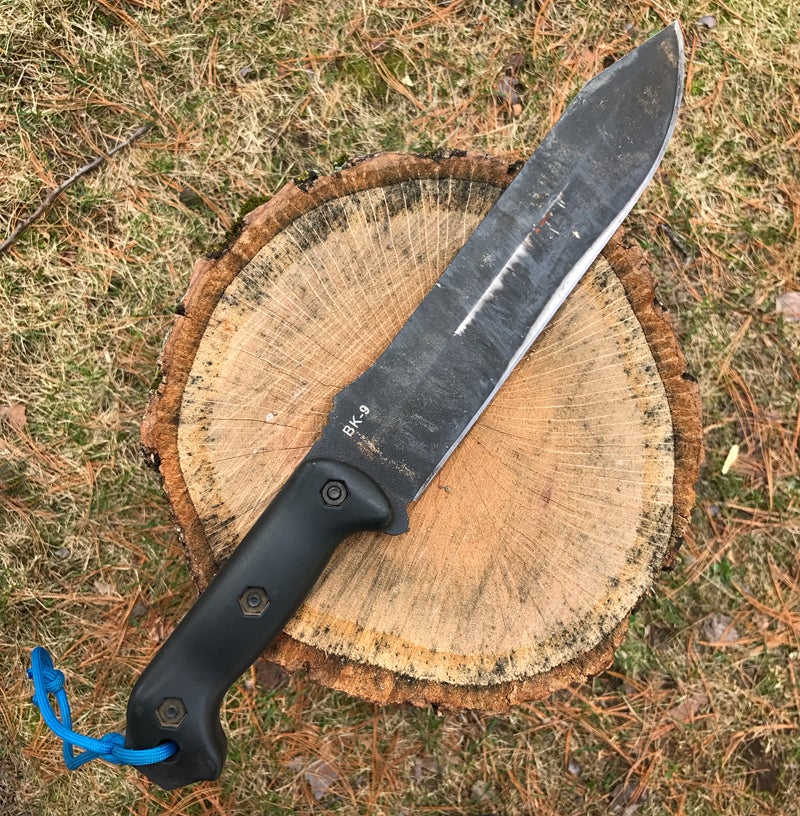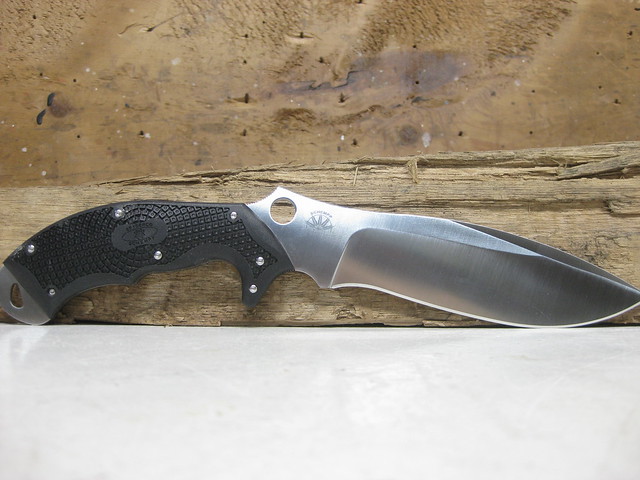How I Learned to Stop Worrying and Love 1095
Tony Sculimbrene 10.31.17

Let me get this out of the way up front. I am a steel snob. The more exotic, the more odd, the better. I love steel and have bought many models that I already own solely for a steel upgrade. I am not a bushcrafter apologist for rudimentary steels. I don’t get the idea that a person would prefer one steel over another solely because the one steel is old and “well-known.” For me, steel is all about performance. Does it do what I need or want it to do? That is the sole consideration.
Over the years I have had the chance to try out all sorts of steels: ZDP-189, all of the M390-type of steels, CPM 3V, Cru Forge V, and all of the more commonly-used steels. I have used these steels on small and medium sized folders and on fixed blades. In the end, after years of use, I can say that 1095, the classic simple steel that we all are familiar with, is probably my favorite choice on a big fixed blade. It has some real limitations in a folder, especially a thinly ground folder, but in terms of the blade stock on something that I will pound on, it is hard to find something that can both absorb abuse and sharpen as easily. For all of the super steels out there, 1095 is, for me, the comfort food steel — a well-known, time-honored classic that just delights. It’s not high-falutin’ or powder metal, but it works.
There are three really illustrative comparisons, each one showing an advantage of a good 1095: 1095 compared to the uber-tough 3V, 1095 compared to the all-around performer S35Vn, and 1095 compared to a relatively soft steel in VG10.
1095 v. 3V: Price
3V is a great steel. With both a high hardness and a high toughness, it is ideally suited for hard use tasks. Blow for blow, chop for chop 3V is, objectively, better than 1095. Comparing my Bark River Bravo 1 LT in 3V to a 1095 blade, the difference, over a large sample size, is clear even to someone like me (a relative fixed blade newb). The 3V keeps its hair-popping edge longer than 1095, and this is not a shocker given 3V’s ingredients and intended use.
But, and this is a big deal, the difference is not huge. It’s there. It’s noticeable. But given the price difference, it is probably not justifiable. If you have a blank check to buy your next fixed blade, 3V is a very good choice. But most folks don’t have a blank check, and for the money a big honking slab of 1095, like those found on a Ka-Bar, will get you into the same ballpark as 3V. It’s nose-bleed seats compared to first row on the field, but 1095 does okay. And it’s usually something like one-quarter to one-tenth the price.
1095 v. S30V/S35VN: Ease of Repairs
I have had quite a few fixed blades with blades of S30V and S35VN. Many were excellent cutters and many held an edge for ages. But, as these steels are wont to do, most developed chips in the cutting edge. Some had really big chips, which tended to get worse if left unaddressed.
I have found that 1095 also chips a bit, but the huge difference between the two is the ability to get rid of chips. S30V and S35VN have well-deserved reputations for being hard to sharpen. I was recently testing an S35VN fixed blade next to my 1095 Schrade SCH36. Both did a little root chopping and both got a large chip on the blade. After a few minutes with the Ken Onion Worksharp, the 1095 had a gleaming convex edge. After about a half hour on strops, sticks, and the Worksharp, the S35VN knife still had a noticeable chip. I am not so worried about the chip spreading on a blade made of hard steel like S35VN, but it’s concerning that real repairs are so challenging.
Fixed blades are going to chip. They are going to get dings and dents. That’s why you have a fixed blade. But if getting rid of those chips is virtually impossible, that’s worth keeping in mind. Oh, and 1095 is about 1/10th the price of S30V or S35VN.
1095 v. VG10: Daily Maintenance
Many Spydercos are made of VG10steel, originally developed by Takefu to do pruning tasks. It makes clean cuts in all sorts of green vegetation, but it’s not the hardest steel in the world. For all its glass-smooth slices, VG10 needs regular maintenance. And it’s clear that VG10 is no longer state of the art steel. Stropping and sharpening VG10 is very difficult. It’s not much easier to sharpen than S30V, despite being noticeably poorer in edge retention.
In this regard, 1095 actually does quite well. Many of the 1095 knives I have had, including the awesome ESEE Candiru, made cuts as clean and precise as VG10. Some of the kitchen knives I have also run 1095 (with the slogan “Guaranteed to Rust” promoting 1095’s high carbon content) and they slice like cat claws. But unlike VG10, which seems to be all but strop-proof, my 1095 blades have stropped wonderfully. And again, 1095 is cheaper than VG10.
Final Thoughts
1095 is an old steel. It’s not stainless, not by a mile. And in a thin stock, its tendency to chip can be a problem. But when you have a thick slab in a fixed blade, 1095 is a great steel. I’d probably choose 3V in a price-blind comparison, but 1095 probably still offers the best combination of performance, price, and sharpenability on the market. Those Becker KaBars have legions of Beckerhead fans for a reason. For a lot of folks this is choir preaching, but for those of use obsessed with powder steels and ever-increasing hardnesses and prices, 1095 is a powerful lesson: old doesn’t necessarily mean outdated.


